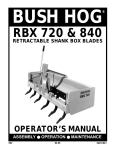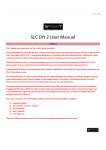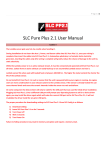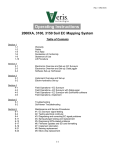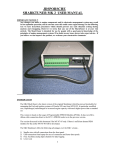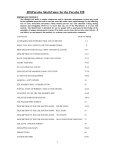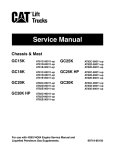Download Steiner PTO Clutch Repair Video – Tip Sheet To start a powershaft
Transcript
Steiner PTO Clutch Repair Video – Tip Sheet To start a powershaft clutch assessment on your John Deere tractor an operator’s manual is absolutely essential. A wise old man once asked me if I could have learned how to do algebra without a textbook…the answer is NO. For anything more in depth than simple adjustments a service manual will be necessary to ensure the job can be completed correctly. Additionally a parts catalog is useful in determining what parts you will require. Having a proper list for placing an order from Steiner Tractor or from John Deere will ensure a much improved experience. If you’ve priced new powershaft clutch facings and plates from your OEM dealer and are still in shock from the price, you can breathe a sigh of relief with purchasing like parts from Steiner Tractor at FAR LESS cost. Here is a list of things to consider when assessing the condition of a tractor equipped with the live Powershaft clutch (includes the following models: R, 50, 60, 70, 80, 520, 620, 720, 820, 530, 630, 730, 830) • • • • • • • • • • Does the powershaft start / stop when the lever or foot pedal is engaged and disengaged? If the powershaft doesn’t mover at all, has the manual engagement/disengagement lever been checked? This is the lever near the foot plate (excluding the R, 80, 820, 830) near the right brake pedal. On models 70, 720, and 730 there is no handle and would need to be engaged or disengaged with an adjustable wrench. *Be sure that the engine is completely stopped before attempting to manually disengage or disengage this lever as damage could result otherwise. Does the powershaft clutch have the correct oil level (see tractor operator manual for proper fill level)? Are there any external oil leaks on the powershaft clutch unit? The usual culprits are the powershaft output shaft oil seal, powershaft clutch fork shaft oil seal, powershaft clutch fill plug loose or missing the aluminum washer (20 / 30 series only). Unless the oil in the powershaft clutch has been changed recently and the refilled with the proper oil for the clutch it’s advisable to drain and refill with either 10w motor oil or a more modern trans-draulic fluid. If when checking the oil you find that it’s milky or grey it’s likely contaminated with water most often from an overzealous pressure washer. If when checking the oil in the powershaft clutch and its thick like gear lube, it’s likely gear lube from one of two sources: Either someone filled the powershaft clutch with gear lube or it’s leaked in past the input shaft oil seal. Both scenarios are bad and can ruin an otherwise good clutch. If the powershaft clutch keeps turning when disengaged it could simply be ‘out-of-adjustment’ or the powershaft brake lining may be bad (this will require disassembling the powershaft clutch). If the powershaft clutch slips under load it may only require adjustment or perhaps a complete overhaul. Follow adjustment procedure and reassess the clutch for function. If it still slips after adjustment or there is no adjustment left (meaning the clutch plates are physically worn out) then disassembly and overhaul of the powershaft clutch unit will be required. Its best practice to remember that the powershaft brake isn’t intended to stop large heavy implements quickly. It can be used to slow them in an emergency but shouldn’t be used to stop them regularly as failure of the powershaft brake lining might occur. One major difference in the numbered series and early 20 series clutch as compared to late 20 series and 30 series clutch is that there is no free-wheel position in the clutch on the early design. The early clutch design is such that it’s either locked and fully engaged or disengaged with the brake engaged. On all of the clutches it’s possible to increase braking power by pressing down on the foot pedal or hand lever but again, keep in mind that it’s not something that should be done all the time or you will have to replace the brake facing regularly. Disassembly Steps Tools absolutely required for disassembly of the powershaft clutch • • • Hydraulic Press Bearing Splitter Flat nosed snap-ring pliers– several heavy-duty external snap rings are used on the powershaft clutch and require heavy duty tools. 1. 2. Drain powershaft clutch housing. It’s advisable to reinstall the drain plug fill with kerosene to capacity and run the tractor with powershaft engaged for approximately 10 minutes. This will ensure a much cleaner powershaft clutch assembly and housing decreasing the need for as much cleaning before reassembly; saving time and towels. Drain washing agent from the powershaft clutch housing. Remove clutch lever or pedal linkage from clutch operating arm. Loosen and remove bolts & nuts holding the clutch cover to the clutch housing. Remove clutch cover and clutch assembly from tractor (some standard, orchard, and Wheatland type models may require removal of some operator station and other sheet metal before this step…see specific service manual for your tractor for more information). It is best to set the clutch assembly on a solid clean workbench or table with plenty of room to accommodate a lot of small parts from the clutch. If the clutch was in the engaged position before removing it from the tractor, it will be necessary to disengage it using two large screwdrivers or pry bars to complete further disassembly. Using a good solid pair of flat nosed snap ring pliers, remove the clutch plate retaining snap ring. Take care not to misplace the washers under the snap ring as they are important during the reassembly phase. Also, note if the thrust washer is attached to the pilot end of the clutch pack shaft (usually small fiber washer that discolors black from years in oil). Remove clutch plate, release springs, disks, adjusting cam, cam balls, and clutch collar. Spread the retaining rings on the brake pins to remove the brake (earlier 20 series and all numbered series 50 60 70 use bolts to retain the brake plate). Using two small short screwdrivers is one effective way of spreading the locking washers. Take care if equipped with a shim pack on earlier 20 series and other numbered series models to keep them all together as they will all be needed for proper adjustment later. Remove the bearing cover and oil seal from around the output shaft. Using a shop press, remove snap ring and then press the clutch shaft out of the housing. The output shaft and gear can now be removed from the housing assembly. Place the clutch shaft assembly in the press with the gear end on a solid surface. Press the clutch cam down far enough to permit removal of the snap ring. Again, note the special washers used between the cam and the snap ring as they will be needed later. It is necessary to put even pressure on opposite sides of the clutch cam hub at the same time. Two 2x4’s cut about 2 inches longer than the top of the shaft will suffice along with a steel bar of some sort to cross the 2x4’s for compressing the cam assembly. When the clutch cam assembly comes apart, be prepared to find a good pile of springs inside. The factory service manuals give information for testing the springs, however I would suggest based on their reasonable cost from JD, just purchase all new springs to ensure uniformity and a strong powershaft clutch. Broken springs are sometimes common to find inside your clutch cam assembly and are common when the clutch has been slipping for some time under heavy load. Often times these springs have been under tension since they were assembled over 50 years ago and have lost a good part of their ‘spring’. With the clutch pack disassembled, it’s time to remove the powershaft/ rockshaft housing from the tractor. This is necessary to inspect the powershaft oil pump and to replace the input shaft oil seal which is on the transmission side of the housing. If there was presence of gear lube in the powershaft clutch replacing the input shaft seal is absolutely necessary! Failure to do so will result in gear lube possibly getting back into the powershaft clutch causing damage to the new linings which are to be installed. Use of an engine hoist a.k.a. cherry picker is recommended but no matter 3. 4. 5. 6. 7. 8. 9. 10. 11. 12. 13. 14. 15. how you choose to do it, use caution as the housing is heavy. If the housing doesn’t come loose easily by use of an 8-12lb sledge hammer and wooden block, CHECK FOR FORGOTTON BOLTS before damaging your housing and your pride. 16. Once the rockshaft / powershaft housing is removed it’s time to remove the clutch fork arm. Before removing the clutch work and arm, using a center punch mark the fork and shaft in relation to one another. Deere didn’t put timing marks from the factory on these parts and it will greatly ease reassembly later. Remove the fork arm retaining ring by expanding the washer to slide over the shaft (a pair of screw drivers usually works along with a needle nose plier) and slide the shaft out of the arm and housing. There is no reason to remove the woodruff key on the clutch fork shaft unless it’s damaged or when replacing the shaft. 17. Remove the bolts which retain the powershaft oil pump housing. There are small recessed areas of the housing where a pry bar can be used to remove the housing as it’s located with two dowel pins. Take care not to mar the housing mating surface as this is a machine fit. 18. With the pump housing out of the way and the idler gear removed, the powershaft clutch drum assembly can be removed from the rear of the housing. The ball bearing should normally come out with the drum shaft. If the bearing doesn’t come out with the drum shaft, take care to inspect the bearing mounting surface on the shaft looking for evidence of scoring. Inspection 1. 2. With the powershaft clutch disassembled clean and inspect all parts. Commonly found are drive discs with worn or metal-to-metal facings along with brake plates that have no wear material. It’s highly recommended that when replacing the clutch discs that new drive and driven discs should be replaced at the same time. Do not reuse old clutch discs with facings that may appear to be okay. Mixing the facings with new ones that have a greater gripping ability will lead to premature failure of those originals. Just like a chain, the powershaft clutch pack is only as strong as its weakest link. 3. Inspect the clutch shaft for damage on the splines. If wear grooves from individual drive discs is too deep, problems with clutch disengagement might occur. Unfortunately the only viable option is to seek out a good used part if the original requires replacement. 4. Inspect end of the shaft which mates with the clutch drum (a pilot type aligning bushing). Although somewhat uncommon, note that the surface is not scored or grooved. Replacement or machining will be required if damaged. 5. Inspect the clutch cam brake ring for pitting or excessive wear. If a new brake plate is installed it’s advisable to reuse only a brake plate which has little wear. If a worn cam brake ring is reused rapid wear of the new brake plate can be expected. 6. Inspect the clutch adjusting cam for nicks or burrs on the adjusting threads. Dress with a small file if threads are damaged to ensure easy adjusting later. Don’t worry about wear on the collar or adjusting cam where the balls wore grooves. They will not likely cause any problem later unless the wear is severe. The number of wear groove sets will indicate how many times the clutch has been adjusted in its life. 7. Inspect all bearings for wear or rust pitting. If needed replace as needed with new bearings available from your dealer. A sturdy hydraulic shop press is needed to remove the powershaft driven gear and bearings from the output shaft. New bearing cups should of course be used when the bearing cones are replaced. 8. In regards to the powershaft oil pump inspect the gear for damage along with the bushing inside the pump housing. 9. Inspect the clutch drum pilot bushing for wear and replace if visibly worn. It’s good practice to slide the clutch shaft pilot into the clutch drum pilot bushing to check fit as it’s much easier than using an inside micrometer. If the old bushing must be removed find it easy to just simply cut threads in the bushing and installing the corresponding bolt to push the bushing out. 10. Inspect the drum shaft where it rides in the oil pump housing bushing looking for any scoring or other appreciable wear. 11. Mark the clutch linkage or take note of where the clevis yoke was positioned in relationship to the rod to aide in reassembly and adjustment later. Remove the clutch linkage from the tractor and take time to make sure all pins and the clevis yokes and their respective jam nuts are free and have a fresh coat of anti-seize lubricant. This is crucial to being able easily adjusting the clutch after reassembly…don’t skip this step or you’ll be hearing ‘I Told Ya So’. 12. If the bearing race for the output shaft that resides in the powershaft housing needs to be replaced you could buy a very fancy and expensive bearing puller, or just by using a simple AC welder run two short weld beads on the bearing race wear surface at 8 o’clock and 4 o’clock then wait for it to cool and it will just pull right out with minimal effort. Reassembly 1. Do not install the clutch drum and shaft back in the housing until you’ve used it to align the clutch pack! 2. If the clutch cam brake plate is to be replaced drive the original one off with a hammer and brass drift, or by using a press and the cam collar. 3. Install a new brake disc on the cam in the same fashion. Using a hydraulic press is highly recommended as the fit is rather tight. The clutch cam collar can be used to install the brake cam disc as it’s the correct diameter. Be sure to stake the collar onto the hub (some have large keyways cut on the cam hub or some have a single drill hole where you can give it a few hits with a center punch. 4. Reassemble the clutch cam hub with new springs. Be sure to install the small springs (later clutches used 3 smaller diameter springs inside the larger ones as compared to 4 on some earlier clutches- refer to the part catalog for your tractor) on even intervals inside the larger diameter springs. Slide the shaft into the clutch cam hub. 5. Place the shaft and cam in the press and set it up just as you disassembled it allowing enough clearance to slide the adjusting washers and hardened washer onto the shaft. Compress the cam until the springs are fully compressed (don’t overdo this just stop when slight resistance is encountered). Release pressure on the cam measuring 5/32 inches and stop to install enough shim washers and the hardened (thicker) washer near the snap ring groove. Normally there are a proper amount of shims for this procedure; however it may be necessary to remove or add a washer. Install the snap ring and remove from press. 6. Install the clutch shaft ball bearing into the powershaft housing cover with the shielded side of the bearing toward the inside and install washer on the clutch shaft. 7. Install the output shaft and gear in the cover and then press the clutch shaft into the ball bearing and reinstall the snap ring. 8. Install the clutch collar, cam balls, and adjusting cam assembly onto the clutch shaft. Then begin installing the clutch plates be first installing one heavy clutch plate. Take care to note the oil holes in the shaft. Line the new clutch disk openings for the clutch release so that the oil holes are not restricted by the internal disc splines. Then install the drive disc (no facings) and a driven disc alternating them until finished. Install the clutch release springs and then the final heavy clutch plate before installing the washer and snap ring. 9. Using the clutch drive hub, slide it down onto the clutch pack taking care to line up the tabs on the discs with the grooves in the hub until it’s fully seated. Next using two large screw drivers or flat pry bars engage the collar and engage the clutch pack. Typically the adjusting cam should be nearly flush with the outer ring for maximum clearance. If set close to correct, you should be able to stick a 1/16” thick washer between the cam and the heavy clutch plate when it’s disengaged. This setting gets you in the ballpark for final adjustment when the clutch is installed in the housing. 10. On early style clutch packs with the brake plate that is bolted into place the clutch should be adjusted so that when it’s engaged the cam brake disc and brake plate are .090 inches of clearance. It may take several attempts to get this right by engaging/disengaging the clutch on the workbench and rechecking the clearance. When the proper clearance is obtained lock the set screw in the cam adjusted by turning it counter-clockwise. 11. Before removing the clutch hub from the clutch pack engage the clutch to ensure the discs stay in alignment. Then remove the clutch hub shaft. 12. Replace all oil seals: clutch oil pump housing, output shaft / cover housing, and clutch arm shaft in powershaft housing. 13. Install the clutch drum and shaft into powershaft housing after reinstalling the ball bearing (if removed). Install the oil pump idler gear and the pump housing. Make sure the mating surfaces are clean; they can be dry when assembled, but I recommend using aviation gasket sealant or Indian head shellac. Tighten the bolts and bend the locking tabs to ensure the bolts will stay put. 14. Install the clutch fork shaft and clutch fork taking care to align the marks that you made before disassembly. Install flat washer on the end of the fork shaft then clamp the split retaining washer onto the groove in the end of the shaft with a large pair of pliers or slip joint pliers. 15. Install a new thrust washer on end of clutch shaft with the smooth side toward the clutch pack. It’s best to smear a dab of sticky grease on the washer surface to make sure it stays in place during installation. 16. Install a new gasket on the housing placing it over the dowel pins to keep it in place. 17. With help from a friend install the powershaft clutch assembly in the housing taking care that the brass fork shoes enter the grooves on the clutch collar. This can be a tricky and trying process. If any of the clutch disc tabs happen to get bent pull the clutch assembly back out and straighten with a screwdriver or plier. It’s also useful to make sure the powershaft driveline is engaged manually so it will stay still when trying to align the clutch pack into the hub. 18. Tighten the outer clutch housing bolts/nuts to 56 ft. lbs. 19. Next use a dial indicator to determine endplay on the output shaft. Using a variety of steel and paper shims set the endplay to .001 to .004 inches. When adjusted secure the cap screws. 20. Fill the clutch housing with oil. Later style clutches have an oil fill level hole while early style clutches should be filled to the large pipe plug opening. 21. Reattach the clutch linkage. 22. Check powershaft brake adjustment (on later 20 series and all 30 series tractors). Engage the powershaft clutch pedal. If it moves to close to the headlamp bracket adjust the small jam nut and set screw on the pivot until it stops interference with the bracket but still allows the clutch to go over-center and remain engaged. If it won’t engage, the clevis on the other end of the rod must be adjusted. If the powershaft fails to stop (start the tractor and engage / disengage the clutch several times) the yoke at the far end of the rod must be adjusted. Remember, shortening the rod will adjust the brake tighter. If the yoke is adjusted be sure to reset the setscrew bracket on the pivot nut if necessary. 23. Recheck the powershaft clutch for adjustment with the tractor engine stopped. On later models with the adjustment indicator rod inside the clutch cover housing the procedure is as follows. Engage the clutch then pull back on the clutch pedal to take up the slack without disengaging the clutch. It works best to have a helper on the tractor operating the clutch while you check the adjustment. With the indicator rod pushed in note the position of the land/ groove. Disengage the clutch and note the position of the rod. If properly adjusted the rod should have moved .090 inches or a total of one land and one groove. If it moves less or more the clutch needs to be adjusted. 24. If adjustment is needed access the clutch through the clutch adjusting hole on the right side of the housing. Keep the clutch in the disengaged but brake not latched position to allow turning of the shaft until the adjusting lock screw is visible. Turn the screw in all the way. Turn the adjusting cam upwards to tighten the clutch and down to loosen the clutch. It’s recommended to move only one slot at a time engaging/ disengaging with each slot until the clutch is adjusted. Each notch on the cam is approximately .015 inches. When the cam is adjusted, turn the adjusting screw counterclockwise until tight in one of the slots on the cam. Install the cover with a new gasket. 25. One earlier 20 series models and most numbered series tractors it may be necessary to check adjustment by placing a wire of approximately .090 inches between the clutch cam brake disc and the brake lining. If the wire won’t fit it will be necessary to tighten the clutch until it fits. Some earlier model numbered series tractors will require an adjustment of .060 to .075 inches (if your clutch cam hub has a locking washer with a bent tang you need to use the .060 to .075 inch adjustment). 26. It’s necessary to ensure the clutch is set properly so that the right amount of spring pressure from the cam is on the clutch discs when engaged. If the clearance is greater than the adjustment specification then your clutch is tighter than it should be. Too tight isn’t good for a clutch either and may result in engine drag and premature wear; however too loose can cause premature wear also. 27. * Please note that on early 20 series tractors the later style powershaft clutch update may have been installed. This would be evident if the adjustment rod is in the housing cover. When assessing the powershaft clutch on models 50 60 and 70 it’s important to know if you have the early or later improved style. If you tractor is earlier than these model serial No. 5017822, 6033676, or 7010776 your clutch adjusting cam should be the ‘lock washer’ type which bending the washer tang over into a slot on the cam is required after final adjustment of the clutch has been made. The proper clearance on the early style is .060 (determined by measuring the clearance between the clutch brake and the clutch cam). If your tractor serial number is higher than the aforementioned, then your tractor should have the improved powershaft clutch which utilized a set screw type adjusting cam which changed to a .090 standoff-clearance. To identify which clutch is in your tractor, remove the large pipe plug on the right hand side of the powershaft clutch housing and peer inside (you may have to turn the powershaft by hand with the tractor shut-off to see which type you have). Please note that your tractor serial number doesn’t mean that someone in the last 50 plus years didn’t install the incorrect clutch assembly during repair that wasn’t necessarily in your tractor from the factory. It will be sometimes necessary to ‘do your homework’ by studying your powershaft clutch assembly with a part catalog in hand to fully determine what parts have been in your tractor. Oil type recommendations While the factory service manuals provided by Deere back when these tractors were built called for regular 10wt oil, today’s transmission/hydraulic oils have specific additive packages that will be much friendlier to and extend the life of your rebuilt powershaft clutch. If you’re not sure what oil was in your powershaft clutch and you only made adjustment without replacing any internal clutch parts, I’d stick with regular 10wt oil as not to upset the balance with the clutch facings. Once your powershaft clutch has been rebuilt with new clutch facings and discs and adjusted to the factory specs, it’s time to give it a try. Whether using a dynometer or perhaps running a grain auger a break-in period of about 20 hours is given by Deere for the proper amount of time for the clutch pack to have proper run-in and that will perhaps require readjustment. In my experience on working tractors, 20 hours of use may be perhaps a bit much in terms of time for readjustment. Be sure to stop the tractor immediately when you notice the powershaft clutch slipping and get it adjusted before using it again. This will ensure the longest possible life from your powershaft clutch. It is normal after a few hours use on the powershaft that models with the brake lock (later 20 series and all 30 series tractors) will fail to keep the powershaft from freewheeling. Re-adjustment of the brake may be required as everything wears in. Take pride in a well-adjusted live multi-wet-disc powershaft clutch. John Deere was well ahead of their time with this clutch design that’s a true pleasure to use compared to other models. If properly maintained it will provide many years of service. A good number of these clutches still today are the original units that left the Waterloo Works factory in Iowa over 50 years ago and serve as a testament to their quality design.






